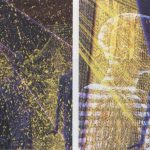Paula Dawson: Luminous Presence
Artist(s):
Title:
- Luminous Presence
Exhibition:
- SIGGRAPH 2007: Global Eyes
-
More artworks from SIGGRAPH 2007:


Creation Year:
- 2007
Medium:
- Reflection hologram
Size:
- 44.5 inches x 66.25 inches
Category:
Artist Statement:
For many years I have been working toward enabling dialogue between real and holographic (virtual) people. In this work, I’m interested in bringing together elements of the way science fiction films have represented holographic characters and some ancient artistic means of depicting legends and stories of people made from, or surrounded by light, such as ghosts and angels who talk to and influence real people. Consequently, the figures in my hologram are not intended to look like real people. They are designed to look like real holograms! It seems to me that thanks to imaginative directors, script writers, and talented special-effects and CG artists in the film industry, the visual language of luminous transparency of holographic characters is now synonymous with the “real” holographic, autonomous presence of another person. Though my holographic characters are static, animation of light and darkness lends a highly
charged sense of communication similar to that described in The Dawn by Richard Jefferies.
Technical Information:
To create a hologram from CG data, the virtual camera from which the scene is recorded must mimic the positions of the viewer’s eyes. Therefore, the camera used for the final render is NOT a creative choice. To work around this problem, each of the figures in the scene were individually adjusted in scale to mimic a filmic lens look. The CG scene incorporated data from two real sources, laser scans (Konica
Minolta Vivid 9i/ Raindrop Geomagic Studio software) of human models (Georgie Dawson and Lexie Hamilton) and photographs of an 18-foot x 6-foot aluminium tessera and pastel drawing. The scene was modeled in Maya using architectural references from Borromini, then textured in Photoshop using reference images of historic gilded mosaics and my own drawings. Procedural shaders were applied to the scan data to give the lined effects of the figures. Particles of varying size and orientation were used to articulate the volume of virtual space surrounding the static figures with a dynamic light field. Finally, 2,057 frames were rendered. From this animation sequence, hundreds of micro-holograms were exposed with six RGB pulsed laser beams. The photofilm was
chemically processed, dried, and laminated to black plastic.
This research was supported under the Australian Research Council’s Discovery funding scheme (project number DP0452144).





